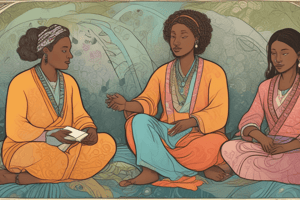Podcast
Questions and Answers
Culture is best described as which of the following?
Culture is best described as which of the following?
- Genetically inherited traits.
- A pattern of shared attitudes, beliefs, and values. (correct)
- Only artistic and intellectual achievements.
- Physical characteristics such as skin color.
What does ethnicity primarily involve?
What does ethnicity primarily involve?
- Common ancestry leading to shared values and beliefs. (correct)
- Shared geographical location.
- Individual preferences in lifestyle.
- Political affiliations.
Which of the following is a characteristic of culture?
Which of the following is a characteristic of culture?
- Culture is only influenced by technology.
- Culture is learned. (correct)
- Culture is genetically determined.
- Culture is static and unchanging.
What is the term for learning and adopting the norms, values, and behaviors of another culture?
What is the term for learning and adopting the norms, values, and behaviors of another culture?
Which term describes viewing one's own culture as superior and judging others based on it?
Which term describes viewing one's own culture as superior and judging others based on it?
What is the integration of a change in one aspect of culture known as?
What is the integration of a change in one aspect of culture known as?
What does 'acculturation' refer to?
What does 'acculturation' refer to?
Which concept involves individuals from one group merging or blending with a second group?
Which concept involves individuals from one group merging or blending with a second group?
What is the borrowing of traits between two cultures called?
What is the borrowing of traits between two cultures called?
Which factor influences race?
Which factor influences race?
What is a 'generalization' in the context of cultural concepts?
What is a 'generalization' in the context of cultural concepts?
Which of the following describes a 'stereotype'?
Which of the following describes a 'stereotype'?
What does 'prejudice' typically involve?
What does 'prejudice' typically involve?
Which of the following involves behavior that treats people unequally because of their group membership?
Which of the following involves behavior that treats people unequally because of their group membership?
What is a 'health disparity'?
What is a 'health disparity'?
What is the term for providing culturally congruent care?
What is the term for providing culturally congruent care?
What is a key aspect of cultural competence in healthcare?
What is a key aspect of cultural competence in healthcare?
Title VI of the Civil Rights Act of 1964 concerns what?
Title VI of the Civil Rights Act of 1964 concerns what?
What does cultural sensitivity begin with?
What does cultural sensitivity begin with?
What should nurses do when collecting a nursing history?
What should nurses do when collecting a nursing history?
What should culturally competent nurses be guided by?
What should culturally competent nurses be guided by?
In what areas can nurses develop to improve cultural competence?
In what areas can nurses develop to improve cultural competence?
Why is it important for all healthcare organizations to provide language assistance?
Why is it important for all healthcare organizations to provide language assistance?
Which of the following is a communication consideration in transcultural nursing assessment?
Which of the following is a communication consideration in transcultural nursing assessment?
What is an important guideline when working with interpreters?
What is an important guideline when working with interpreters?
Which tool can be used for assessing health literacy?
Which tool can be used for assessing health literacy?
What does cultural competence require in nursing?
What does cultural competence require in nursing?
Which factor is part of social orientation in transcultural nursing?
Which factor is part of social orientation in transcultural nursing?
What should a nurse do when exploring health care plans for the patient?
What should a nurse do when exploring health care plans for the patient?
A patients ethnicity is considered which of the following?
A patients ethnicity is considered which of the following?
Which of the following is a factor of biologic variation?
Which of the following is a factor of biologic variation?
Which of the following is a factor of time?
Which of the following is a factor of time?
Which of the following is a communication factor?
Which of the following is a communication factor?
A patients definition of health is considered which of the following?
A patients definition of health is considered which of the following?
Flashcards
Culture
Culture
A pattern of shared attitudes, beliefs, self-definitions, norms, roles, and values among those who share a language or live in a region. It includes practices that define them as a collective.
Ethnicity
Ethnicity
Common ancestry leading to shared values/beliefs. A powerful determinant of identity.
Race
Race
Influenced by physical or biological characteristics.
Enculturation
Enculturation
Signup and view all the flashcards
Acculturation
Acculturation
Signup and view all the flashcards
Assimilation
Assimilation
Signup and view all the flashcards
Diffusion
Diffusion
Signup and view all the flashcards
Ethnocentrism
Ethnocentrism
Signup and view all the flashcards
Transcultural Nursing
Transcultural Nursing
Signup and view all the flashcards
Cultural Competence
Cultural Competence
Signup and view all the flashcards
Cultural sensitivity
Cultural sensitivity
Signup and view all the flashcards
Linguistic Competence
Linguistic Competence
Signup and view all the flashcards
Culturally Congruent Care
Culturally Congruent Care
Signup and view all the flashcards
Health Literacy
Health Literacy
Signup and view all the flashcards
Study Notes
- Culture and ethnicity are important considerations in healthcare
- Cultural competence involves providing culturally congruent care
Key Topics
- World diversity
- U.S. diversity
- Migration
- Healthcare equity
- Title VI of the Civil Rights Act of 1964
- The Joint Commission
- Accreditation standards for culturally competent care
Culture
- Culture is a shared pattern of attitudes, beliefs, self-definitions, norms, roles, and values
- Culture occurs among those who share a language, way of communicating, or live in a defined geographic region
- Culture includes practices that people share and that define them as a collective
Ethnicity and Race
- Ethnicity is based on common ancestry, leading to shared values and beliefs
- Ethnicity is influenced by both culture and common ancestry
- Ethnic Identity is a powerful determinant of one's identity
- Race is influenced by physical or biological characteristics
Characteristics of Culture
- Culture is learned through enculturation
- Culture is symbolic, including language
- Culture is shared, involving things like gender roles
- Culture is integrated, such that a change in one part impacts the whole
Cultural Concepts
- Generalizations: broad statements about a group
- Stereotypes: oversimplified and often negative beliefs about groups
- Prejudice: preconceived judgments about groups
- Discrimination: actions based on prejudice
- Disparity: differences in outcomes
- Health disparity: differences in health outcomes
- Race: a social construct based on perceived physical traits
- Racism: prejudice, discrimination, or antagonism directed against someone of a different race based on the belief that one's own race is superior
Acquisition of Cultural Identity
- Acculturation is the exchange of cultural features through direct contact between groups
- Assimilation is when individuals from one group merge with a second group
- Diffusion involves borrowing traits between two cultures
- Ethnocentrism is viewing one’s own culture as superior and judging others by one's own standards
- Socialization occurs through family, community, school, and spiritual institutions
- Rituals also play a role in cultural identity
Enculturation Example
- A high school student from the United States spends a summer abroad with a family in Switzerland, learning norms, values, and behaviors of another culture
Transcultural Nursing
- The goal is to provide culturally congruent care
- Transcultural nurses can be specialists, generalists, or consultants
- Transcultural nurses function in diverse clinical practice settings
- Transcultural nurses are committed to cultural openness
- Madeleine Leininger developed:
- The Sunrise Model
- The Theory of Cultural Care Diversity and Universality
Cultural Competence
- Cultural competence means interacting with and appreciating people of different cultures and beliefs
- It can be individual and organizational
- Cultural sensitivity begins with recognizing cultural differences
- Cultural competency in nursing requires underlying acceptance of patient’s health beliefs
- Adapting care is necessary to meet the unique needs and perspectives of each individual
Cultural Competence Elements
- Culturally congruent care is essential
- It involves multidimensional cultural competencies
- It requires balancing multiple cultures which includes the nurse, the healthcare system and the patient
Cultural Competence and the Nursing Process
- Key components of assessment
- The Transcultural Theory and Assessment Model
- The Transcultural Assessment Model
Assessment Considerations
- Biological variations
- Environmental control
- Time
- Social orientation
- Communication
- Space
- Culturally unique individual
Additional Areas for Consideration
- Health disparities
- Family dynamics
- Ethics
- Spirituality
- Communication
- Stress and coping
- Fatigue
- Mood and affect
Assessment in the Nursing Process
- Includes consideration of:
- Nutritional needs
- Health beliefs
- Socioeconomic level
Collecting a Nursing History
- Avoid assumptions
- Listen carefully
- Rephrase for clarity
- Stay respectful and nonjudgmental
Linguistic Competence
- The ability to communicate effectively and convey information so diverse audiences can easily understand
Audiences to Consider
- Those with limited English proficiency
- Those with disabilities
- Those who are deaf or hard of hearing
- Those with low literacy skills or who are not literate
National CLAS Standards
- (Culturally and Linguistically Appropriate Services) set of standards
- All healthcare organizations must provide:
- Language assistance
- Information about the availability of language assistance
- Competent individuals to provide language assistance
- Print and multimedia materials in languages commonly used by the served population
Working with Interpreters
- Use only qualified interpreters
- Ensure interpreters are competent in medical terminology
- Ensure interpreters know about confidentiality and impartiality
- Position interpreters close to the patient
Communication Considerations
- Culture influences how feelings are expressed verbally and nonverbally
- Consider aspects like:
- Touch
- Facial expressions
- Eye contact and movement
- Body posture
Care Plan Development
- Must include professional action and decision-making strategies
- Involves:
- Cultural maintenance
- Cultural care accommodation or negotiation
- Cultural care repatterning or restructuring
Culturally Competent Nurses
- Nurses utilize culturally relevant information when assessing, diagnosing, planning, and implementing care for diverse patients
- Language and linguistics is important
- Include individualized care
- Community referrals are important
Assessing Health Literacy
- Health literacy includes the capacity to obtain, process, and understand basic health information
- Watch for behaviors that indicate a literacy deficit
- Assessment tools include:
- The Short Assessment of Health Literacy in Spanish and English
- The Rapid Estimate of Adult Literacy in Medicine—Short Form
Studying That Suits You
Use AI to generate personalized quizzes and flashcards to suit your learning preferences.




